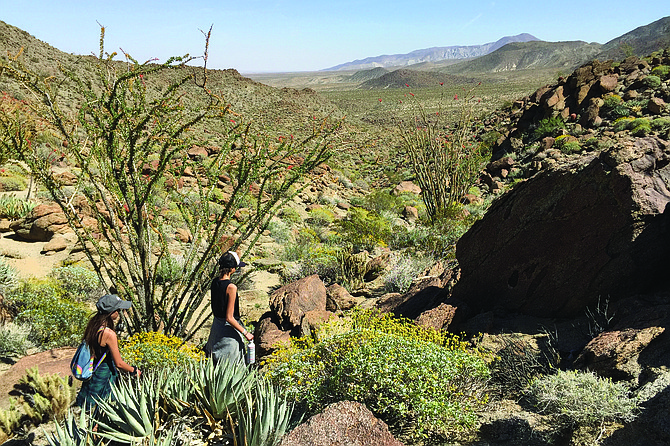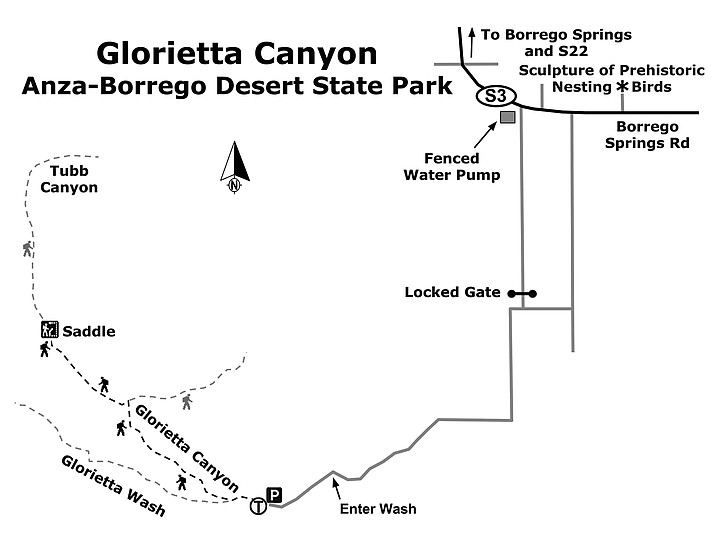 Facebook
Facebook
 X
X
 Instagram
Instagram
 TikTok
TikTok
 Youtube
Youtube

This little canyon in Anza-Borrego Desert State Park is only a hop, skip, and a short off-road drive southwest of downtown Borrego Springs. It is a popular local canyon for day hikes, and surprisingly, internationally known thanks to its feature location in world-renowned Brazilian author Paulo CoeIho’s work entitled The Valkyries. While in Borrego Springs, Coelho was drawn to “Glorieta” Canyon where he erected a “Black Madonna” on a boulder at the mouth of the canyon, affixing it with cement. It was discovered some time later by a park ranger who removed it, as Coelho had predicted in his book: “Maybe the guards will take it away when they find it here…They watch over the desert as if it were a flower garden.” If you search on the north side of the canyon mouth, you can still see the cement on the boulder where the Madonna rested.
It is said that Glorietta Canyon was originally given that name because the canyon was a glorious place to explore, especially in spring during wildflower blooms. Indeed, the canyon is a popular haunt for wildflower baggers, but with the single-lane access road and room for only 20 vehicles, it can get very crowded.
Glorietta Canyon has been deeply etched along a portion of the Yaqui Ridge detachment fault—a major tectonic feature of the immediate landscape that has been eroded and exhumed along the mountain front of Pinyon Ridge. The canyon itself is tight and rocky, providing ample opportunity for getting up close to nature. The well-used trail climbs northwest. You have to skirt one rocky section on the climb up. At just under 1 mile, you descend into an open area where the trail splits. The trail to the east (right) leads down a steep, rocky, officially unnamed canyon, with several dry falls that may be difficult to navigate. For this hike, turn west (left) and then follow the trail upwards in a northwest direction for another 0.5 mile to a rocky saddle from which there are views to the north and into Tubb Canyon. You can explore the ridges and views from here before returning the way you came.
There are also numerous side hikes and longer loops that can be made by heading down from the viewpoint and northeast, following Tubb Canyon and then circling back east along the desert foothills. For these options, you definitely need a map and GPS, as the trail “disappears” in sections that go around dry waterfalls or boulders.
The mouth of Glorietta Canyon is also a good place to see chuckwallas (Sauromalus ater), and in the sandy wash zebra-tailed lizards (Callisaurus draconoides). This showy lizard is possibly North America’s fastest reptile. Sprinting at up to 18 miles per hour, it often rises up on its hind legs and runs bipedally. When running, zebra-tailed lizards curl their tails over their backs, showing the zebra-like stripes on the bottom of the tail. This likely draws the attention of predators to the expendable tail and away from the head and body. Desert spiny lizards (Sceloporus magistera) and granite spiny lizards (Sceloporus orcutti) can be seen peeking through the rocky landscape of the inner canyon.
The canyons of Pinyon Ridge, including Glorietta, support a variety of cactus, shrubs and annuals, and some rare and unique plants, including the spidery-flowered Coulter’s lyrepod (Lyrocarpa coulteri), Bigelow’s ragged rock flower (Crossosoma bigelovii), the low-growing scarlet spiderling (Boerhavia coccinea), and the sand blazing star (Mentzelia involucrata) with its edible seeds that were prized by Native Americans. You’ll also find numerous chuparosa, indigo bush, brittlebush, spiny senna, ocotillo, barrel cactus, species of cholla, and many other desert beauties.

GLORIETTA CANYON (Anza-Borrego Desert State Park)
Get close to nature in glorious Glorietta Canyon


This little canyon in Anza-Borrego Desert State Park is only a hop, skip, and a short off-road drive southwest of downtown Borrego Springs. It is a popular local canyon for day hikes, and surprisingly, internationally known thanks to its feature location in world-renowned Brazilian author Paulo CoeIho’s work entitled The Valkyries. While in Borrego Springs, Coelho was drawn to “Glorieta” Canyon where he erected a “Black Madonna” on a boulder at the mouth of the canyon, affixing it with cement. It was discovered some time later by a park ranger who removed it, as Coelho had predicted in his book: “Maybe the guards will take it away when they find it here…They watch over the desert as if it were a flower garden.” If you search on the north side of the canyon mouth, you can still see the cement on the boulder where the Madonna rested.
It is said that Glorietta Canyon was originally given that name because the canyon was a glorious place to explore, especially in spring during wildflower blooms. Indeed, the canyon is a popular haunt for wildflower baggers, but with the single-lane access road and room for only 20 vehicles, it can get very crowded.
Glorietta Canyon has been deeply etched along a portion of the Yaqui Ridge detachment fault—a major tectonic feature of the immediate landscape that has been eroded and exhumed along the mountain front of Pinyon Ridge. The canyon itself is tight and rocky, providing ample opportunity for getting up close to nature. The well-used trail climbs northwest. You have to skirt one rocky section on the climb up. At just under 1 mile, you descend into an open area where the trail splits. The trail to the east (right) leads down a steep, rocky, officially unnamed canyon, with several dry falls that may be difficult to navigate. For this hike, turn west (left) and then follow the trail upwards in a northwest direction for another 0.5 mile to a rocky saddle from which there are views to the north and into Tubb Canyon. You can explore the ridges and views from here before returning the way you came.
There are also numerous side hikes and longer loops that can be made by heading down from the viewpoint and northeast, following Tubb Canyon and then circling back east along the desert foothills. For these options, you definitely need a map and GPS, as the trail “disappears” in sections that go around dry waterfalls or boulders.
The mouth of Glorietta Canyon is also a good place to see chuckwallas (Sauromalus ater), and in the sandy wash zebra-tailed lizards (Callisaurus draconoides). This showy lizard is possibly North America’s fastest reptile. Sprinting at up to 18 miles per hour, it often rises up on its hind legs and runs bipedally. When running, zebra-tailed lizards curl their tails over their backs, showing the zebra-like stripes on the bottom of the tail. This likely draws the attention of predators to the expendable tail and away from the head and body. Desert spiny lizards (Sceloporus magistera) and granite spiny lizards (Sceloporus orcutti) can be seen peeking through the rocky landscape of the inner canyon.
The canyons of Pinyon Ridge, including Glorietta, support a variety of cactus, shrubs and annuals, and some rare and unique plants, including the spidery-flowered Coulter’s lyrepod (Lyrocarpa coulteri), Bigelow’s ragged rock flower (Crossosoma bigelovii), the low-growing scarlet spiderling (Boerhavia coccinea), and the sand blazing star (Mentzelia involucrata) with its edible seeds that were prized by Native Americans. You’ll also find numerous chuparosa, indigo bush, brittlebush, spiny senna, ocotillo, barrel cactus, species of cholla, and many other desert beauties.

GLORIETTA CANYON (Anza-Borrego Desert State Park)
Get close to nature in glorious Glorietta Canyon